ARTICLES TAE KWON-DO: IDENTITY AND TECHNICAL BALANCE OF A MARTIAL WAY by Manuel E. Adrogué |
Within the martial arts community it is commonly heard that Tae Kwon-Do is a "kick
predominant combat sport", description that offers a derogatory connotation when
faced by people who have been spending years of sacrifice and joy in what they
consider an art form, or a way of personal growth through the use of hands
and feet. It has been always difficult for me to accept that label for this
activity. A poor understanding of TKD´s basic technical principles, and
its unique training method show those opinions to be far from true Tae Kwon-Do,
and thus misleading. Having dealt with many TKD instructors, I´ve found impossible to establish a common "Tae Kwon-Do style": some black belts are young athletes with lightning-fast high kicks and very few hand techniques sparring dressed in red and blue vests; others, advocate strong, well-focused forms of japanese origin and snow-white uniforms (as New York´s Grandmaster S. Henry Cho); some TKD masters practice and teach their self-created sets of forms (as Master H.U.Lee, of A.T.A.), others wear coloured uniforms, and think of their martial art in terms of explosion and "power moves" (as world reknown Master Hee Il Cho, who includes boxing in his teaching program), and still others, as Los Angeles based Master Jun Chong, teach joint-manipulation, slow-motion self defense drills and weapons. So, TKD seems a lot like what people think of the "Jeet Kune Do Concept": a combat art with a specific method to ensure knowledge of some technical principles that, once understood and practiced thoroughly, can lead to a truly personal style. Kenpo Karate´s pioneer Ed Parker once said that "Style is the word used to describe the manner in which an individual applies and executes the system he has learned." Historical reasons for diversity In general terms, the description of Grandmaster He-Young Kimm on the evolutive phases of TKD is very enlightening: as he explains, the first years were greatly influenced by japanese karate, so this martial art was practiced as a hyung (forms) oriented system, such as Grandmaster Hwang Kee´s the Moo Duk Kwan Tang Soo Do (often called "Korean karate"). The second phase was when Gen. Choi Hong Hi, Nam Tae Hi and other masters heading the old Korea Tae Kwon-Do Association gathered the old kwan to unify and adopt the Tae Kwon-Do name. This "uniformation era" was a gigantic step towards the consolidation of TKD, as all instructors had to practice the same forms and basic technique and assume their martial art identity. These masters brought some balance to their system by addying kicking techniques to the hyung practiced, improving sparring methods and emphasizing relaxation in the execution of basics. That was when Tae Kwon-Do was officially born, in april 11th., 1955. The third step was the developement of TKD sparring into a modern combat sport, with unified rules, specialized training methods, and distinctive movements by the head masters of the W.T.F. in South Korea. But being the previous information truthful, we must not forget that most masters in their formative years, as they came from different Korean styles, they had different training backrounds, and while most of them gave up their original names and adopted the TKD official basics and hyung to give birth to the Korean national pride, Tae Kwon-Do, there were also many advanced concepts that were not standarized, and thus, not all the TKD knowledge can be traced back to the unifying "official entities" (I.T.F., W.T.F., or even the original kwan). Two different aspects As in religious activities, martial arts have two distinct aspects: the "collective", by which the main concepts and practices are spread and made available to the mayority of the people by simple, sure and proven guidelines (in our examples, doctrine textbooks, or standarized techniques found in ranking programs), and the "personal" aspect, which is an advanced stage in which the individual is near his own maturity (in the same examples, our personal relationship with God, or the discovery of simplicity through basic technique, as Aikido´s Morihei Ueshiba is said to have accomplished). In martial arts, it is said that that the person who archieves the highest form of this personal practice, will trascend the limits of what he learnt, developing his own style to spontaneous, natural moves and no set-patterns. Shotokai´s Shigeru Egami explains that "in our physical moves, there are those that are natural and those that are not. Through practice, we can learn to differentiate between the two and learn to acquire natural movements". The purpose of this article is to expose Tae Kwon-Do and its special method in its combat aspects. Not being a style that must not be confused as to think that TKD is void of identity, for it can be recognized by a special teaching method that makes sure each student receives instruction in every chapter of the "TKD composition cicle". The five chapters of the "TKD composition cicle" If we don´t take in account the psicological, physiological and social benefits that can be obtained through the practice of TKD, we can say it could be approached as a "method of combat". From that perspective, and accepting the fact that the only "true reality" to where training aims is actual combat, we must accept it cannot be reproduced in a normal Tae Kwon-Do class (by "reality" we mean an unexpected encounter, with full-commitment, full-power blows, no rules, no weight divisions, without safety gear, with environmental weapons available and the possibility of uneven number of fighters). So the "TKD composition cicle" analyzes this "reality" by its components, dedicating different chapters to deal with them and provide a well-rounded program of instruction for learning martial arts during the individuals´ whole life. Correct body mechanics are taught through forms, correct timing, target and tool selection are learnt by sparring, and correct power dosification and body alignment are provided by impact training. I.)Forms: Although very knowledgeable people have said that forms (prearranged solo patterns) are "the esence" of TKD, we must disagree with that statement. We prefer to quote Master Hee Il Cho, who once stated that forms are a truly beautiful and useful part of martial arts practice, and that those styles that not include them in their training miss a lot. The Tae Kwon-Do way of executing forms ("hyung", which can be called Tul or Poomse, depending if it refers to Chan Hun -Gen. Choi´s system- or W.T.F. system) teaches the student to shift his bodyweight in different directions through wide and "heavy" basic stances that will enable him to perform moves that, according to biomechanical research, have been thought to produce maximum force. In forms, the static aspect is emphasized, and the goal is to obtain maximum power in each technique: the individual learns to use his own body by controlled breathing, hip and wrist twisting, notion of his own center of gravity -dan jun-, and correct body positioning. Each technique is performed to covering its whole range of motion, going through its imagined target with full power and speed. The martial artist performs isolated, single and heavy power-packed blows. The stances must be exact, and the martial artist should have a strong muscular complexion to make him able to go through the motion relaxed, and suddenly tense his body for a fraction of a second, at the point of impact of the technique. "Power in hitting comes from a quick twist of the waist, not a swinging, swaying movement; Power is accentuated by the coordination of the whole body in the follow through" are very important teaching sentences of the late Bruce Lee that make hyung a valuable learning experience. In TKD forms tend to follow a continuous rythm, which derives from taoist conception of universal continuity and eternal change. In the mental aspect is where forms tend to provide a way of progression throught the performance of techniques in an unconscious state of mind, similar to what is done in zen buddhist meditation exercises. That "empty mind" state was pursued in forms training by masters as Egami, who wrote that "the mind is useless, but the movements will have been acquired by the body... you must practice until your body understants. This is practice." II.)Sparring: This aspect is the most similar to actual combat, as the speed and timing are very similar, there is an actual physical confrontation against two wills and there are no prearranged actions: everything must be spontaneous. In this chapter, the dynamic factor is the key. Sparring positions tend to be light, mobile and undefined, moves are everchanging, continuous and, if perfomed by an advanced black belt, simple and very subtle in nature. The key word for sparring is adaptability. "Never move out of context with your opponent, bhut relate your action to his action", taught Ed Parker. In most TKD dojang semi-contact sparring is practiced in a way that insures against unnecesary violence, but puts the participants facing potentially "unpleasent" situations (a side kick to the ribs, a punch to the chest, or a roundhouse kick to the face might be some frecuent examples). Techniques, compared to the way they are practiced in forms, are performed with less power (perhaps 70 or 80 %), combined and with economy of motion. Blows very rarely show themselves in their "full-range fashion", but are practiced in fast, snap-like actions to return to a safe on-guard position. The martial artist performs combined, multiple and percussive, fluid actions. If we could say that while forms training makes TKD look similar to japanese karate, in sparring it could be said that concepts are closer to boxing or kenpo, except for that instead of employing hand combinations, kicking techniques are favoured. Should we accept that TKD is a "kick-oriented" method? In our opinion, we should accept that in the first stages, it is certainly so. In order to insure the quality and effectiveness of the explosive, powerful kicks that have made this martial art famous, beginners are taught at first in a "protected environment": no leg-grabbing allowed, no low kicks, and few hand techniques. They are encouraged to develop balance, and use their -usually- young physiques in an expansive, intense way. If they were taught very effective punching methods from the start, they would find themselves too comfortable with those techniques, and probably never strive to acquire good kicking skills. That is why in kickboxing bouts, all good kickers are people who after some years of basic traditional training, at black belt level, have learnt boxing skills; its very rare to see a good hand technician be interested in the difficulties of striking his opponents´ highest part of the body with his owns´ lowest. But as time goes by, the realistic TKD artist must learn to use his hands, and footwork in a "not-so-protected" environment: sweeping actions and low kicks should be allowed, as well as low kicks and all kind of hand techniques (punches, trapping, etc.). That situation will put the individual closer to reality, and make his reevaluate the effectiveness of his kicks. If in forms training we learn to relate ourselves with our body, in sparring we learn to relate ourselves with other people, and react to their unpredictable moves. The question is not to act but to react in permanent, personal relation. It is not about thinking, but "it is body feel that suggests a harmonious interplay of body and spirit, both inseparable", as Lee stated. Other masters have said that is must be kept in mind that mind and body are the two wheels of a cart, and correct practice is not to emphasize one over the other. In sparring practice, the Tae Kwon-Do warrior should follow 17th century Rinzai Zen priest Bunan: "In the state of being dead while still living, one´s actions are at their best." III.)Impact training: As we know, "to every action there is a reaction of equal itensity and angle, but opposite direction". So, when performing strikes in hyung (forms) or kibon hyung (basics), as the artist executes power moves without making impact on anything, he must provide his own reaction by pulling the opposite elbow, twisting the hip and extending the back leg (in the forward stance). In solo practice, the body absorbs the shock. Because of that, the TKD artist must be cautious of not hyperextending his attacking limbs: many experienced masters have warned about the danger of over-forced forms practice. If one were to produce the reaction to the technique when applying that same technique into an actual target (a heavy bag, or a danryon gu -forging post-), he would find that that object already provides the ressistance that constitutes the reaction to the action of his strike. So this impact training teaches that the "self-made" reaction must be reduced to a minimum (for form and balance), and actually striking is very effective to correct inapropiate body/hand/feet alignment. It is also great for muscular endurance, and a good way to build up confidence by making evident the results of the other "chapters" of TKD training. Other important aspects of this area are that both "single, full power" and "combined, fast" techniques can be practiced: both the "snappy" okinawan-style kicks and the muay-thai "follow through" kicks have always been part of TKD, and the different types of force applications should be known and used by the complete martial artist. IV.)Partner practice: No TKD class in the world excludes the repetition of drills in combat-like situations. They are hypothetical combat situations, with an attacker and a defendant. These drills can be classified in two: a) Forms-like drills: They are called by the name of "one, two or three step sparring", and use the stances, movements and rythm found in forms training against prearranged attacks. They are excersices on the application of full-power on an opponent, stopping the technique very close to the target. "Practice with the intent of felling an opponent with a single blow or single kick", taught Grandmaster Shigeru Egami. b) Sparring-like drills: Being the favourite training tool in sport TKD, they tend to be smooth, active and less formal combinations that imply continuous interaction between two martial artists. Speed and timing are emphasized. V.)Traditional Self Defense practice: This chapter bears a name that might lead to erroneous interpretation. Physical training, sparring, forms and impact practice are the most important parts of self defense training, and that is why they employ most of the time spent in TKD training. But there is a chapter in this art that avoids the use of strikes in order to nullify an aggression, by employing joint-locking actions, parrying blocks, throws, falling techniques and special point attacks, combined with circular, slow foot work. Multiple-opponent situations and strategy are examined in this chapter. "Students should train to be alert not only to their front, but to what happens to their sides and back... The instructor teaches just a little part of the art. Its versatile applications must be discovered by each student through practice and constant training", wrote Grandmaster Ueshiba in his "Advices for aikido practice". This aspect -probably the highest form of practice- tends to illustrate the soft part of TKD training, and teaches physical concepts (flexed elbows, relaxed shoulders, erect spine, etc.) that, once understood, can be very useful to archieve a total image of the TKD method. The harmony of a method I´ve heard very frecuently that TKD is a "hard style" of martial arts. That is not true. In the TKD method the "hard" part (muscular, physically intense combat oriented practice) prevails during the first decades of training. But in the "TKD composition cicle", as in life, there is an ever-present fact: the harmony of complementary opposites (Um-Yang). These ideas, which represent femineity, indirectness, darkness, softness, humidity and centripetal (Um) and masculinity, directness, light, hardship, dryness and centrifugal (Yang) play a very important role in understanding the TKD method. The hard, intense and forceful forms practice will not be correct unless coordination and relaxation are taken into account, greatly improved by ultra-low speed hyung and breathing practice (soft aspect). I wander about the physical prowess that Egami reached, as he refered to "old style" (hard) and actual (soft), when he wrote "looking at the kata (forms), as practiced today, as a whole, the movements from the beginning natural stance to the ending natural stance should be liquid and flowing, the performance should be beautiful and rythmic, full of vitality and radiating power. Body and spirit must be one entity, and the power must be centrated. Breathing must continue without interruption. In former practice, there used to be a pause between one movement and the next; now movement continues rythmically, without pausing and it is fluid and flexible. Appearences can be deceptive. Although the movements look weak, in fact the are not. When the body and movements were rigid and the power dispersed, the techniques looked strong. Actually it was only the performer who felt that his blows were powerful. The only satisfactiobn was on his part. That is, it was only self satisfaction. The oponent did not feel the blow to be strong, and the practice of stopping movement was actually dangerous. It could mean death to the person who does it. A weak-looking, soft and relaxed punch in which the power is concentrated will pierce anything". In sparring, the common explosive "full-speed, contact, limited target" system can sometimes be replaced by a medium speed -no fake attacks- semi contact sparring to all body areas, which will enhace coordination, defensive skills, hand and head placement, and other aspects that can benefit the complete TKD artist. So, if this Korean martial art generally proposes a "hard" (Yang) way, in the Traditional Self Defense practice we can find the soft aspects generaly associated to arts as hapkido, aikido, tai chi chuan or pa kua chang. It is very interesting to notice that mechanics of the Yang penetrating TKD and Shotokan follow through strikes, and the Um hapkido or kenpo snap strikes are just different ways of studying a same phenomena: quoting Lee, "a punch is just a punch, a kick is just a kick". Truly efficient fighters have been able to apply hard and soft in armonious interaction. Ray "Sugar" Leonard or Muhammed Ali knew best, because they could "dance like a butterfly, and sting like a bee" in soft defense, mobile footwork and hard, strong punching. "There is a great difference between softness and weakness", reads an ancient japanese saying. The knowledge of Tae Kwon-Do is built by "bricks of habit". Each new day of study adds another brick, so your future will depend on how firm your foundation of basics was constructed. "As you spend time practicing, spend it well.", advised Ed Parker, who added "As you endeavor to research the martial arts, learn to develop tenacity and purpose. Do not apply only truths which you have discovered, byut others that are meritoriously promising... Be creative. Creativity is not wrong if you stick to logic and sound reasoning. A comprehensive understanding of principles and how to properly apply them is another prerequisite when to are attempting to be creative. Creativity leads to higher learning, higher plateaus of experimentation, and the realization of how little you really know." The harmony of a way We must remember that combat is just one aspect of TKD, which is a method towards evolution as a better human being. Tough but graceful hands adequate for hard work and fine arts are desirable; strong character and a soft, loving should be the aim of a true martial artist. The fighting (body) aspect is just a way, a means, so the mind (education of intelligence) and spirit (honesty, righteousness and love to God and all of his creatures) come first. So next time you think of TKD, remember three things are needed to progress: Practice (in TKD your technical level is determined not by how long you first wore your white belt, but how many hours you´ve spent in your practice), Patience (time is avengeful to those who act without its help), and Study (a good instructor who has gone further in the way -and still getting better-, and your own personal research will overcome all adversities). Always be open-minded and remember the Mu Do Jungshin (martial way attitude) of harmony in life. Notes (May 2002): 1) This article was published in Inside TaekwonDo magazine, June 1994. Although the author has changed opinion in reference to some historical matters mentioned in this piece, this version has not been amended, as its content still remains in good standing in material aspects. 2) About the author: Manuel E. Adrogué, 4th Dan, is a Tae Kwon Do instructor and business lawyer living in Buenos Aires, Argentina. He is also a martial arts freelance writer that has been learning TKD since 1983 under Master Pedro Florindo in the Escuela Argentina de Tae Kwon-Do. His Master´s open attitude has given him the chance to learn and practice with some of the world’s leading technicians in Korean martial arts. Bibliography: *"Ed Parker´s Infinite Insights into Kenpo" by Ed Parker, Delsby Publications, Los Angeles, 1985.- *"El Espíritu del Aikido" by Kisshomaru Ueshiba, Editorial Eyras, Madrid.- *"Tao of Jeet Kune Do" by Bruce Lee, Ohara Publications, Burbank, 1984.- *"The Way of Karate. Beyond Technique" by Shigeru Egami, Kodansha International Ltd., Tokyo, 1976.- |
ARTICLES TAE KWON-DO: IDENTITY AND TECHNICAL BALANCE OF A MARTIAL WAY by Manuel E. Adrogué |
As published by Inside TaekwonDo Magazine |
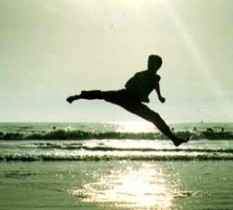
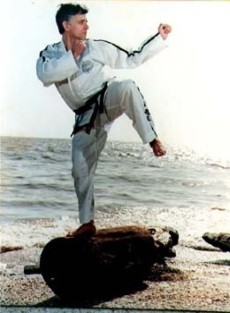

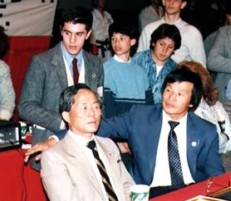
General Choi, Hong Hi & Master Park, Jung Tae (Manuel stood behind) |
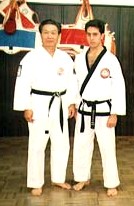
Manuel with Grandmaster Henry Cho |
Manuel with Hwang Kee & son |
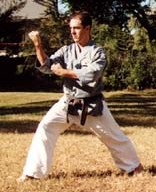
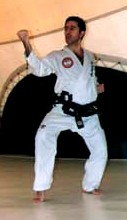
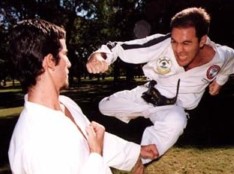
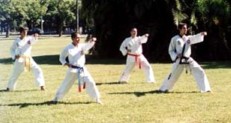
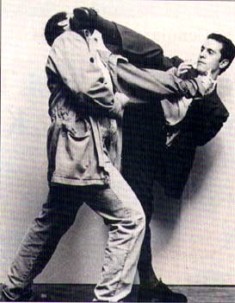
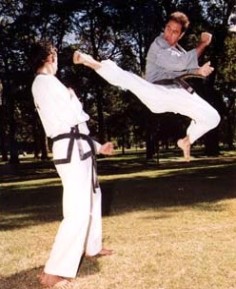
All the above photographs are of Manuel, either demonstrating various aspects or
techniques of Taekwon-do, or with some of the various Masters he has met & trained
with. For further pictures of Manuel & a short bio: Click Here |
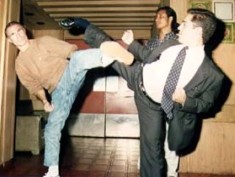
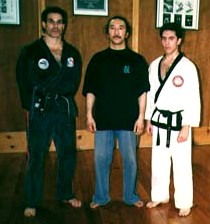
Manuel trades kicks with Bill Wallace |
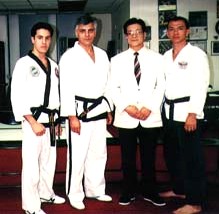
Manuel withJi HanJae |
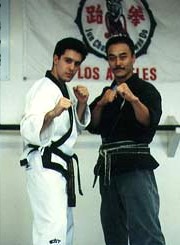
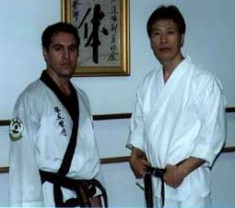
Manuel with Grandmaster Hee Il Cho |
Manuel with Kong Young Bo |
Manuel with Jun Chong |